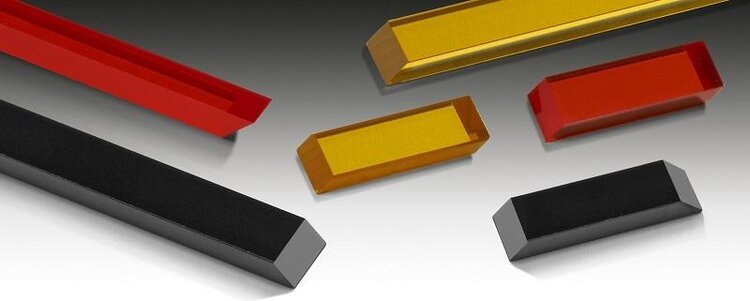The Beginner’s Guide to Attenuated Total Reflectance (ATR)
/The Beginner’s Guide to Attenuated Total Reflectance (ATR)
Attenuated Total Reflection (ATR) is a contact sampling technique in the field of optical spectroscopy, which involves shining an IR beam through a medium of high refractive index (such as an ATR Crystal) and taking advantage of a specific angle of incidence that causes almost all radiation to be reflected back. This is referred to as Total Internal Reflection.
When total internal reflection occurs, a part of the reflected light energy escapes the crystal and extends outward for 0.1 to 5 μm. This extension of light is referred to as an evanescent wave. ATR sampling utilizes this wave to measure the attenuation (reduction) of the intensity of specific infrared wavelengths, which corresponds to the vibrational frequencies of molecular bonds in the sample.
Wave me up inside!
The ATR Process
Sample Contact - The sample of interest is brought into contact with the crystal's surface. The contact creates an evanescent wave at the crystal-sample interface, penetrating a short distance (a few micrometers) into the sample.
IR Radiation Interaction - Infrared light is directed at the crystal's surface at an angle greater than the critical angle for total internal reflection. As the light strikes the interface, some of it is internally reflected, but a portion of the light's energy is absorbed by the sample in the evanescent wave region.
Attenuation of IR Signal - The sample's absorption of infrared energy results in a decrease in the intensity of certain infrared wavelengths, aligning with the vibrational frequencies of molecular bonds within the sample.
Spectral Analysis - The attenuated IR radiation is then analyzed using a detector, such as a Fourier-transform infrared (FTIR) spectrometer. The resulting spectrum represents the characteristic absorption bands of the sample, providing information about its molecular composition and structure.
Benefits of ATR
Minimal Sample Preparation:
ATR requires little to no sample preparation, reducing the time and effort needed for analysis.
Versatility:
It can analyze a wide range of sample types, including liquids, solids, pastes, and gels.
High Sensitivity:
ATR is sensitive to small amounts of sample, making it suitable for analyzing small quantities or trace components.
Non-destructive:
ATR does not damage the sample during analysis, allowing for repeated measurements.
However, this does not mean ATR is infallible, it comes with some downsides as well. Namely penetration depth is limited to the length of the evanescent wave and is therefore incapable of piercing deep into a sample. The requirement for the crystal to be in contact with the sample as well rules out any tests that involve samples that would dissolve or damage the crystal and corrupt the experiment as well as requiring the crystal be cleaned in between tests to avoid cross contamination.
Tools of the Trade for ATR
There are a range of different devices and materials that assist in the ATR process. The crystals that facilitate the evanescent wave are extremely important to the process and choosing the right material for your experiment is the key to a proper wavelength reading. ATR prims have different shapes designed to optimize certain parts of the measurements. ATR fiber optic probes are designed to be used in situations where tests are necessary on-site, being optimal in factories and large samples that aren’t transportable.
ATR Accessories/Sample Holders
ATR accessories play a crucial role in enhancing the sampling capabilities of infrared spectrometers and can be snapped into most commercial models. By allowing the analysis of various sample forms without extensive preparation, ATR spectroscopy provides a versatile and efficient analytical technique for identifying and characterizing materials in research, industry, and quality control applications. Whether using single or multiple reflection ATR accessories, these tools enable researchers and analysts to gain valuable insights into the molecular composition of a wide range of samples, making them indispensable in the field of infrared spectroscopy.
Types of ATR Accessories
Single Reflection ATR: In a single reflection ATR accessory, the infrared beam undergoes a single internal reflection at the crystal-sample interface. Single reflection ATR accessories are suitable for samples with moderate or weak absorption, and they are commonly used in routine analysis.
Multiple Reflection ATR: Multiple reflection ATR accessories, such as the diamond attenuated total reflection (DTGS) crystal, involve multiple internal reflections, increasing the pathlength and sensitivity of the measurement. These accessories are preferred for samples with low concentration or weak signals.
Hemispherical ATR: Hemispherical ATR accessories employ a hemisphere-shaped crystal to provide a broader sampling area, making them suitable for irregular or large sample surfaces.
Flow-Through ATR: Flow-through ATR accessories allow continuous analysis of liquid samples by passing the sample through a flow cell equipped with an ATR crystal. They are commonly used in online monitoring and reaction studies.
Reflection-Transmission ATR: This type of ATR accessory combines ATR with traditional transmission sampling. It allows the measurement of both thin films and bulk properties of a sample.
ATR Crystals and Prisms
ATR crystals are essential components in ATR spectroscopy instruments. They enable the collection of infrared spectra from samples through the principle of total internal reflection. When infrared light passes through an ATR crystal and strikes the sample in contact with the crystal surface at a specific angle, it undergoes multiple internal reflections within the crystal/sample interface. This results in an evanescent wave that penetrates a short distance into the sample, allowing for the analysis of its infrared absorption characteristics. Several materials are commonly used to manufacture ATR crystals, each with its unique properties and advantages.
Diamond: Diamond ATR crystals offer exceptional hardness, chemical inertness, and a broad spectral range from mid-infrared to far-infrared. They are ideal for analyzing harsh or chemically aggressive samples, and their durability ensures long-term stability and reusability. However, diamond ATR crystals can be expensive.
Zinc Selenide (ZnSe): ZnSe ATR crystals are widely used due to their good optical properties in the mid-infrared region (wavelengths around 2.5 to 16 μm). They are suitable for a wide range of samples, including liquids, solids, and powders. However, ZnSe is relatively soft and can be prone to scratching, which may affect the quality of measurements over time.
Germanium (Ge): Ge ATR crystals have excellent optical properties in the mid-infrared region and are often used for high-energy applications. They are relatively robust but should be handled with care to avoid degradation.
Silicon (Si): Si ATR crystals are commonly used for applications in the mid-infrared region. They are more durable and cost-effective than some other materials but have a narrower spectral range compared to ZnSe or diamond.
example image, just to be Crystal clear
“It’s a Trap… ezoid” - Admiral ATR
ATR Prism Shapes
When it comes to Attenuated Total Reflection (ATR) spectroscopy, researchers have various options for ATR prism shapes, including trapezoid, parallelogram, and prism rod. Each shape offers unique advantages and is suited for different applications. Let's compare these ATR prism shapes:
Trapezoid ATR Prism:
Shape: Trapezoid prisms have four sides, with two parallel sides and two non-parallel sides.
Optical Path Length: Trapezoid prisms typically have a shorter optical path length compared to parallelogram prisms and prism rods. This means that the penetration depth of the evanescent wave into the sample may be shallower.
Advantages: Trapezoid prisms are often used for analyzing liquid samples or samples that require a constant flow or circulation. They are also suitable for cases where the sample size is relatively small.
Limitations: The shorter optical path length may limit the sensitivity for certain applications, especially when analyzing materials with low concentrations.
Parallelogram ATR Prism:
Shape: Parallelogram prisms have four sides with opposite sides parallel to each other.
Optical Path Length: Parallelogram prisms typically have a longer optical path length compared to trapezoid prisms and prism rods. This allows for a deeper penetration of the evanescent wave into the sample, increasing sensitivity.
Advantages: Parallelogram prisms are often preferred for analyzing solid samples, especially powdered or granulated materials. They provide enhanced sensitivity and are suitable for samples with low concentrations.
Limitations: Parallelogram prisms may be less suitable for analyzing liquids, especially those that require constant flow or circulation.
Prism Rod ATR:
Shape: Prism rod ATR elements are cylindrical in shape.
Optical Path Length: Prism rods typically have a longer optical path length compared to trapezoid and parallelogram prisms. This is beneficial for achieving deeper penetration of the evanescent wave into the sample.
Advantages: Prism rods are versatile and can be used for a wide range of sample types, including liquids, solids, and powders. They offer good sensitivity and are often used in both laboratory and industrial settings.
Limitations: The cylindrical shape of the prism rod may make it less convenient for certain applications, especially when dealing with very small samples or samples in specialized environments.
ATR Probes
An ATR fiber optic probe is a specialized type of ATR accessory that allows for remote or on-site analysis of samples using ATR spectroscopy. Unlike traditional ATR probes, which are directly integrated into the spectrometer, ATR fiber optic probes offer the flexibility to analyze samples in hard-to-reach or hazardous environments. Examples of the uses for an ATR Probe can be:
On-site analysis: ATR fiber optic probes allow for in-situ analysis of solid, liquid, and even gaseous samples. They are particularly useful for analyzing samples that cannot be easily transported to a laboratory for testing.
Process monitoring and control: ATR fiber optic probes find applications in industrial process monitoring and control. They can be integrated into production lines to analyze samples continuously and ensure quality control during manufacturing processes.
Environmental monitoring: ATR fiber optic probes can be used in environmental monitoring applications to assess soil composition, water quality, and other environmental parameters in the field.
Forensic analysis: ATR fiber optic probes are valuable tools in forensic science for the analysis of trace evidence, such as fibers, paints, and drugs.
Petrochemical industry: ATR fiber optic probes are used to study petroleum products, including crude oil and refined products, providing valuable data for refining processes and quality control.
This is just some of the many uses the probe can offer someone looking to analyze FTIR readings outside of the lab, the probe makes it all possible.
Conclusion
Attenuated Total Reflectance (ATR) plays a vital role as and FTIR analysis proces with diverse applications across numerous industries and fields. Utilizing precise manufacturing methods, top-notch materials, and advanced design, these crystals, probes and prisms enable precise and accurate control of IR, rendering them indispensable in contemporary FTIR systems.
As always, if you have any questions or custom designs, please reach out to us at info@firebirdoptics.com.
Here’s to your success!
Firebird Optics







